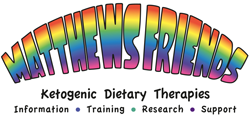
More about the ketogenic diet
Discover more about how the ketogenic diet can help someone living with Dravet Syndrome in this detailed information from the International League Against Epilepsy (ILAE).
The ketogenic diet is a medically prescribed diet for people with drug-resistant epilepsy and can work well for Dravet Syndrome.
Ketogenic diets have restricted carbohydrates and are high in fat. Protein is always included – the amount depends on which version of the four types of ketogenic diet you are using. Each type is tailored to a person’s individual needs.
Ketogenic diets are worth considering if appropriate medications for Dravet Syndrome have not worked.
As with any other treatment, you shouldn’t try the ketogenic diet without first discussing it with a medical professional. The diet needs to be monitored by a dietician and a neurologist who have experience in ketogenic diets.
The diet should be started with no other changes to treatment being made.
Someone on the diet will need to have blood tests every few months. Their family or carer will need to fill out weekly reports for their dietician, especially at the start, to make sure they have enough ketones. These are a type of chemical that your liver produces when it breaks down fats.
In a normal diet, our energy comes from carbohydrates such as rice, bread, pasta, vegetables, fruit and sugar. When we eat carbohydrates, they change into glucose and are used by the brain for fuel. Glucose can only be stored in the body for around 24 to 36 hours. If it isn’t used then, it is converted into fat.
If you don’t eat carbohydrates, your body’s metabolism will burn fat for its fuel. When we burn fat, we produce ketones. It is being in this ‘ketotic’ state that can reduce seizures and improve someone’s quality of life.
It’s possible to tell within three months whether a diet is helping or not. If the diet is beneficial, it’s usually recommended that the person stays on it for two years before slowly being weaned off. In most cases, the benefits of the diet remain even after being weaned off, and people can go on to a normal diet.
When our daughter was eight years old, her seizures started to get a lot more frequent and worse. One option offered by her doctors was the ketogenic diet. It wasn’t easy. In fact, her seizures got worse for a while, but what I saw was a much brighter, engaging and talkative little girl. It was amazing. Gradually, over some months, the diet started to help with her seizures, so much so that we managed to wean her off one treatment and lower other meds.Mum to a teenager with Dravet Syndrome

Discover more about how the ketogenic diet can help someone living with Dravet Syndrome in this detailed information from the International League Against Epilepsy (ILAE).

Get support, including information and recipe ideas, from Matthew’s Friends, a charity specialising in all types of ketogenic diets.

Learn about additional therapies that can help someone living with Dravet Syndrome, from physiotherapy to occupational therapy.